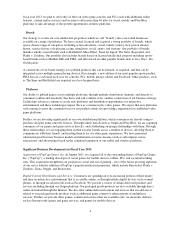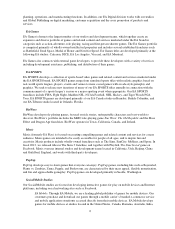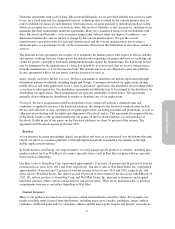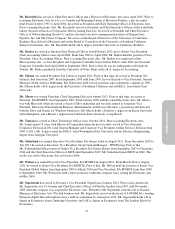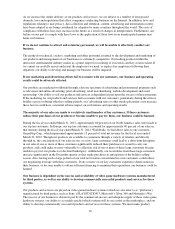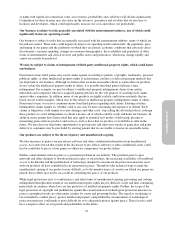Electronic Arts 2012 Annual Report Download - page 98
Download and view the complete annual report
Please find page 98 of the 2012 Electronic Arts annual report below. You can navigate through the pages in the report by either clicking on the pages listed below, or by using the keyword search tool below to find specific information within the annual report.Our adoption of new business models could fail to produce our desired financial returns.
We are actively seeking to monetize game properties through a variety of new platforms and business models,
including online distribution of full games and additional content, free-to-play games supported by advertising
and/or micro-transactions on social networking services and subscription services such as our MMO role-playing
game Star Wars: The Old Republic. Forecasting our revenues and profitability for these new business models is
inherently uncertain and volatile. Our actual revenues and profits for these businesses may be significantly
greater or less than our forecasts. Additionally, these new business models could fail for one or more of our titles,
resulting in the loss of our investment in the development and infrastructure needed to support these new
business models, and the opportunity cost of diverting management and financial resources away from more
successful businesses.
Technology changes rapidly in our business and if we fail to anticipate or successfully develop games for
new platforms and services, adopt new distribution technologies or methods, or implement new
technologies in our games, the quality, timeliness and competitiveness of our products and services will
suffer.
Rapid technology changes in our industry require us to anticipate, sometimes years in advance, which
technologies we must implement and take advantage of in order to make our products and services competitive in
the market. We have invested, and in the future may invest, in new business strategies, technologies, products,
and services. Such endeavors may involve significant risks and uncertainties, and no assurance can be given that
the technology we choose to adopt and the platforms, products and services that we pursue will be successful and
will not materially adversely affect our reputation, financial condition, and operating results.
Our product development usually starts with particular platforms and distribution methods in mind, and a range
of technical development goals that we hope to be able to achieve. We may not be able to achieve these goals, or
our competition may be able to achieve them more quickly and effectively than we can. In either case, our
products and services may be technologically inferior to our competitors’, less appealing to consumers, or both.
If we cannot achieve our technology goals within the original development schedule of our products and services,
then we may delay their release until these technology goals can be achieved, which may delay or reduce revenue
and increase our development expenses. Alternatively, we may increase the resources employed in research and
development in an attempt to accelerate our development of new technologies, either to preserve our product or
service launch schedule or to keep up with our competition, which would increase our development expenses.
We may also miss opportunities to adopt technology, or develop products and services for new platforms or
services that become popular with consumers, which could adversely affect our revenues. It may take significant
time and resources to shift our focus to such technologies or platforms, putting us at a competitive disadvantage.
If we release defective products or services, our operating results could suffer.
Products and services such as ours are extremely complex software programs, and are difficult to develop and
distribute. We have quality controls in place to detect defects in our products and services before they are
released. Nonetheless, these quality controls are subject to human error, overriding, and reasonable resource
constraints. Therefore, these quality controls and preventative measures may not be effective in detecting defects
in our products and services before they have been released into the marketplace. In such an event, we could be
required to or may find it necessary to voluntarily recall a product or suspend the availability of the product or
service, which could significantly harm our business and operating results.
We may experience outages and disruptions of our online services if we fail to maintain adequate
operational services, security and supporting infrastructure.
As we increase our online products and services, most recently with the launch of our online commerce and
content delivery system Origin, and the launch of Star Wars: The Old Republic, we expect to continue to invest
in technology services, hardware and software - including data centers, network services, storage and database
technologies - to support existing services and to introduce new products and services including websites,
14


